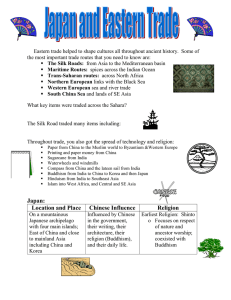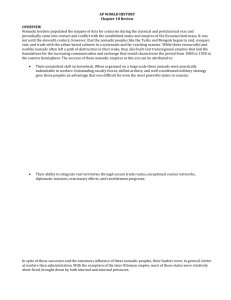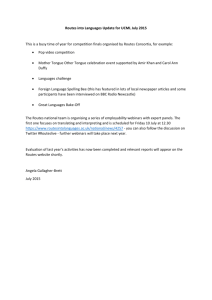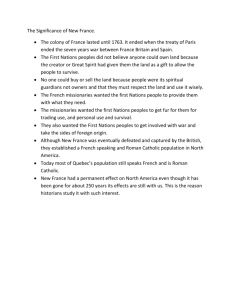Nomads/Pastoral Peoples, Migration, and Trade Routes Nomads/Pastoral Peoples
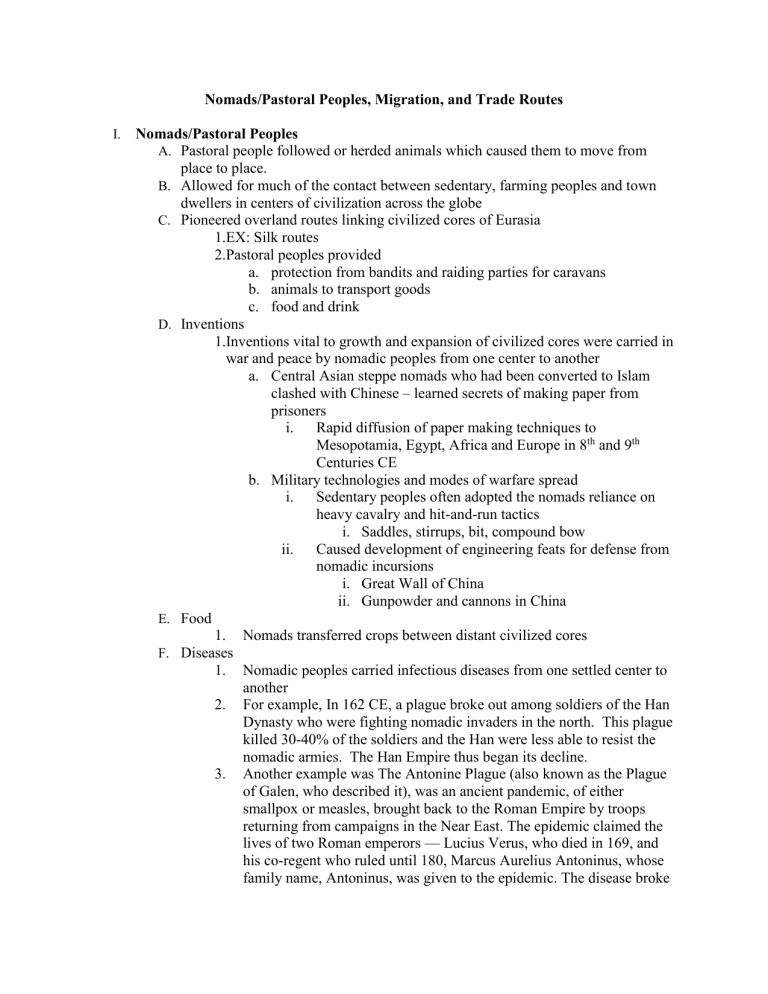
Nomads/Pastoral Peoples, Migration, and Trade Routes
I.
Nomads/Pastoral Peoples
A.
Pastoral people followed or herded animals which caused them to move from
B.
place to place.
Allowed for much of the contact between sedentary, farming peoples and town
C.
D.
dwellers in centers of civilization across the globe
Pioneered overland routes linking civilized cores of Eurasia
1.EX: Silk routes
2.Pastoral peoples provided a.
protection from bandits and raiding parties for caravans b.
animals to transport goods
Inventions c.
food and drink
E.
F.
1.Inventions vital to growth and expansion of civilized cores were carried in war and peace by nomadic peoples from one center to another a.
Central Asian steppe nomads who had been converted to Islam clashed with Chinese – learned secrets of making paper from prisoners i.
Rapid diffusion of paper making techniques to
Mesopotamia, Egypt, Africa and Europe in 8 th
and 9 th
Centuries CE b.
Military technologies and modes of warfare spread i.
Sedentary peoples often adopted the nomads reliance on heavy cavalry and hit-and-run tactics i.
Saddles, stirrups, bit, compound bow ii.
Caused development of engineering feats for defense from nomadic incursions i.
Great Wall of China ii.
Gunpowder and cannons in China
Food
1.
Nomads transferred crops between distant civilized cores
Diseases
1.
Nomadic peoples carried infectious diseases from one settled center to another
2.
For example, In 162 CE, a plague broke out among soldiers of the Han
Dynasty who were fighting nomadic invaders in the north. This plague killed 30-40% of the soldiers and the Han were less able to resist the nomadic armies. The Han Empire thus began its decline.
3.
Another example was The Antonine Plague (also known as the Plague of Galen, who described it), was an ancient pandemic, of either smallpox or measles, brought back to the Roman Empire by troops returning from campaigns in the Near East. The epidemic claimed the lives of two Roman emperors — Lucius Verus, who died in 169, and his co-regent who ruled until 180, Marcus Aurelius Antoninus, whose family name, Antoninus, was given to the epidemic. The disease broke
G.
H.
out again nine years later, according to the Roman historian Dio
Cassius, and caused up to 2,000 deaths a day at Rome, one quarter of those infected. Total deaths have been estimated at five million.
Disease killed as much as one-third of the population in some areas, and decimated the Roman army. The epidemic had drastic social and political effects throughout the Roman Empire, particularly in literature and art
Environment
1.
Pastoralist directly affected the environment around them as the animals they herded often caused erosion in the grasslands due to their grazing and eating.
Nomadic/Pastoral Peoples and History
1.
Nomadic peoples have periodically affected and at times dominated the course of civilized history, but were often unable to sustain their influence to the extent sedentary agrarian peoples and city-dwellers have
II.
Bantu Migrations (800
B.C.E.
– 1000
C.E)
A. Why it occurred
1. Bantus (a group of people speaking one of a family of languages) lived in
Western Africa in area around present day Niger
2.
1.
Migrations probably began due to overpopulation caused by people fleeing the drying Sahara desert
B. How it occurred – 2 possibilities
Use of iron allowed Bantus to easily conquer hunting and gathering societies that were still using stone
2. Peaceful migration and huge population growth led to the spread of
Bantus
C. Impact of the Migration
1.
Brought use of iron and the spread of agriculture to eastern and southern
Africa.
2.
Brought long-distance trade, especially to East Africa.
3.
Bantu culture flourished throughout Africa
1.If one draws a line from Benis (present day Ivory Coast) to Somalia,
90% of all languages spoken below that line are part of the Bantu family of languages
III.
IV.
Maritime Migrations
A.
Polynesian Migrations (1500 BCE to 1000 CE)
1.
Did not immediately impact civilizations on mainland Eurasia
2.
Like Bantu, the migration was gradual
3.
Came from mainland Asia and expanded eastward to Fiji, Tonga, and Samoa
4.
Left no written records
5.
Cultivated transplanted foods and domesticated animals as they moved to new islands
Trade Routes
A.
Silk routes – China to Mediterranean; China to India; China to Mesopotamia /
Islamic World
1.Specialized merchants based in urban centers or trading towns along the
Silk Road a.
Often controlled transport and trading operations b.
Read passage below:
Caravan trade on the routes of the Silk Road was connected not only with high profits but also with huge risks. That is why merchants tried to find companions, to form big caravans consisting of hundreds and even thousands of armed people.
But nothing could protect merchants from arbitrary rules of governors and attacks of nomad tribes.
Therefore, trying to save their lives, merchants seldom passed the Silk Road from one end to the other.
More often they exchanged the goods in some of the intermediate trade cities.
However, both the states and nomads were interested in preservation of trade routes. Governors received income from collecting customs duties in the cities standing on caravan routs. To avoid losses governors of Asian countries passed the strict laws aimed at merchants’ protection. In fact, trade was an exchange; money served only as a tally. Merchants valued their goods in money and exchanged it for other goods with equivalent price.
Caravans sometimes consisted of dozens to several thousands of pack animals. Pack animals were taken care of by servants and porters. Very often caravans hired translators.
Caravan trade required complex servicing. Therefore, along the way caravanserais were built. There were khudzhars for merchants and servants, premises for horses, camels, mules and donkeys, fodder and provisions. Sometimes, merchants could sell or buy goods in bulk, to find out about trade news and prices in caravanserais.
There were special merchants or even the entire companies that undertook goods transportation organization. The considerable role in trade development was played by nomads-cattlemen. They accompanied caravans, gave their cattle for food and transportation; whole dynasties specialized in caravan trade which would have been impossible without them.
B.
C.
Trans-Saharan Trade Routes (800
– 1500 ***time when was most important but existed on a small scale before this)
1.What it involved a.
Trade of gold for salt in sub-Saharan Africa. This gold was then sent north across the Sahara to trading cities of northern Africa. b.
The introduction of camels from Arabia made this trade possible
2.Impact a.
Formation of several states that became quite wealthy because they became centers of trade.
i.
Ancient Kingdom of Ghana (different from present day
Ghana) ii.
iii.
Mali
Songhai
Indian Ocean Trading System (1 – 1600 ***saw introduction of European dominance)
1.What it involved - Stretched from east Africa to southern China a.
Three distinct regions of trade i.
South China Sea
ii.
iii.
East India and Southeast Asia
West India + East Africa + Persian Gulf
2.
Impact - Diffusion
D.
a.
Technology i.
Lateen Sail ii.
Dhow Ships b.
Compared to trading in Silk Routes, volume was less (because of long distances) but variety of good traded was quite impressive
(considering different regions involved)
Ideas, Religions, and Technology
1.Religions a.
Buddhism and Islam spread peacefully along trade routes throughout Central Asia, East Asia, Southeast Asia, and Africa
2. Artistic Motifs a.
Art of Hellenistic World created by Alexander the Great’s Empire spread by trading contacts in N. Africa, N. India and W. China

